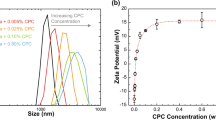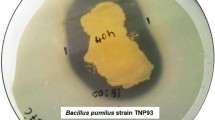Abstract
In order to reduce the toxicity of Clostridium perfringens fermentation broths used in vaccine preparation, we developed two-phase aqueous systems for removal of toxin-activating proteases. Removal of the proteases inhibits the conversion of protoxin to active toxin. In order to establish the conditions under which the phase separation occurs, binodal curves, formed by poly(ethylene glycol) (PEG) and sodium citrate, were investigated at different values of pH and PEG molar mass. A 24-experimental design was used to evaluate the influence of PEG molar mass and concentration, citrate concentration and pH on protease partition coefficient, removal factor and protease removal yield. It has been found that simultaneous increase in PEG molar mass and decrease in citrate concentration remarkably improved the removal factor, whereas the protease removal yield showed an opposite trend. The best conditions for the system under consideration (removal factor of 2.69 and yield of 116%) were obtained at pH 8.0 using PEG molar mass of 8000 g mol−1 and concentrations of PEG and citrate of 24 and 15%, respectively.



Similar content being viewed by others
References
Albertsson PA (1986) Partition of cell particles and macromolecules. Wiley-Interscience Press, New York
Azevedo EO, Lobato FCF, Abreu VLV (1998) Avaliação de vacinas contra Clostridium perfringens tipos C e D. Arq Bras Med Vet Zootec 50:239–242
Balasubramaniam D, Wilkinson C, Cott KV, Zhang C (2003) Tobacco protein separation by aqueous two-phase extraction. J Chromatogr A 989:119–129
Borrmann E, Schulze F, Cussler K, Hänel I, Diller R (2006) Development of a cell culture assay for the quantitative determination of vaccination-induced antibodies in rabbit sera against Clostridium perfringens epsilon toxin and Clostridium novyi alpha toxin. Vet Microbiol 114:41–50
Boukes FS, Wiersma TJ, Beaujean D, Burgmeijer RJ, Timen A (2004) Tetanus prophylaxis in general practice. Ned Tijdschr Geneeskd 148:2172–2173
Box GEP, Hunter WG, Hunter JS (1978) Statistics for experimenters. John Wiley and Sons, New York
Bradford MM (1976) A rapid and sensitive method for the quantification of protein utilizing the principle of protein-dye binding. Anal Biochem 72:248–254
Cavalcanti MTH, Porto TS, Neto BB, Porto ALF, Lima-Filho JL, Pessoa A Jr (2006) Aqueous two-phase systems extraction of α-toxin from Clostridium perfringens type A. J Chromatogr B 833:135–140
Cavalcanti MTH, Porto TS, Porto ALF, Lima-Filho JL, Pessoa A Jr (2004) Large scale purification of Clostridium perfringens toxin: a review. Braz J Pharm Sci 40:151–164
Cisneros M, Benavides J, Brenes CH, Rito-Palomares M (2004) Recovery in aqueous two-phase systems of lutein produced by the green microalga Chlorella protothecoides. J Chromatogr B 807:105–110
Esmanhoto E, Kilikian BV (2004) ATPS applied to extraction of small molecules—polycetides—and simultaneous clarification of culture media with filamentous microorganisms. J Chromatogr B 807:139–144
Hatheway CL, Whaley DN, Dowell VR Jr (1990) Epidemiological aspects of Clostridium perfringens in foodborne illness. Food Technol 34:77–90
Jin F, Matsushita O, Katayama S-I, Jin S, Matsushita C, Minami J, Okabe A (1996) Purification, characterization, and primary structure of Clostridium perfringens lambda-toxin, a thermolysin-like metalloprotease. Infect Immun 64:230–237
Leighton TJ, Doi RH, Warren RAJ, Kelln RA (1973) The relationship of serine protease activity to RNA polymerase modification and sporulation in Bacillus subtilis. J Mol Biol 76:103–122
Li M, Peeples TL (2004) Purification of hyperthermophilic archaeal amylolytic enzyme (MJA1) using thermoseparating aqueous two-phase systems. J Chromatogr B 807:69–74
Lobato FCF, Moro E, Umehara O (2000) Avaliação da resposta de antitoxinas beta e épsilon de Clostridium perfringens induzidas em bovinos e coelhos por seis vacinas comerciais no Brasil. Arq Bras Med Vet Zootec 52:313–318
Marcos JC, Fonseca LP, Ramalho MT, Cabral JMS (2002) Application of surface response analysis to the optimization of penicillin acylase purification in aqueous two-phase systems. Enzyme Microbial Technol 31:1006–1014
Mayerhoff ZDVL, Roberto IC, Franco TT (2004) Purification of xylose reductase from Candida mogii in aqueous two-phase systems. Biochem Eng J 18:217–223
Neto BB, Scarminio IC, Bruns RE (2002) Como fazer experimentos: pesquisa e desenvolvimento na ciência e na indústria. 2nd edn. Editora da Universidade de Campinas, Campinas-SP, Brazil
Oliveira GGG, Silva DP, Roberto IC, Vitolo M, Pessoa-Jr A (2003) Partition behavior and partial purification of hexokinase in aqueous two-phase polyethylene glycol/citrate systems. Appl Biochem Biotechn 105:787–797
Oliveira LA, Sarubbo LA, Porto ALF, Lima-Filho JL, Campos-Takaki GM, Tambourgi EB (2002) Partition of trypsin in aqueous two-phase systems of poly(ethylene glycol) and cashew-nut tree gum. Proc Biochem 38:693–699
Pancera SM, Silva LHM, Loh W, Itri R, Pessoa-Jr A, Petri DFS (2002) The effect of poly(ethylene glycol) on the activity and structure of glucose-6-phosphate dehydrogenase in solution. Colloid Surface B 26:291–300
Porto ALF, Sarubbo LA, Moreira KA, Melo HJF, Lima-Filho JL, Campos-Takaki GM, Tambourgi EB (2004) Recovery of ascorbic oxidoreductase from crude extract with an aqueous two-phase system in a perforated rotating disc contactor. Braz Arch Biol Technol 47:821–826
Rabelo APB, Tambourgi EB, Pessoa-Jr A (2004) Bromelain partitioning in two-phase aqueous systems containing PEO–PPO–PEO block copolymers. J Chromatogr B 807:61–68
Rito-Palomares M (2004) Practical application of aqueous two-phase partition to process development for the recovery of biological products. J Chromatogr B 807:3–11
Schoepe H, Neubauer A, Schlapp T, Wieler LH, Baljer G (2006) Immunization with an alphatoxin variant 121A/91-R212H protects mice against Clostridium perfringens alpha toxin. Anaerobe 12:44–48
Téllez S, Casimiro R, Vela AI, Fernández-Garayzábal JF, Ezquerra R, Latre MV, Briones V, Goyache J, Bullido R, Arboix M, Dominguez L (2006) Unexpected inefficiency of the European pharmacopoeia sterility test for detecting contamination in clostridial vaccines. Vaccine 24:1710–1715
Thompson DR, Parreira VR, Kulkarni RR, Prescott JF (2006) Live attenuated vaccine-based control of necrotic enteritis of broiler chickens. Vet Microbiol 113:25–34
Vernau J, Kula MR (1990) Extraction of proteins from biological raw material using aqueous polyethylene glycol-citrate phase systems. Appl Biotechnol Biochem 12:379–404
Zafarani-Moattar MT, Sadeghi R, Hamidi AA (2004) Liquid-liquid equilibria of an aqueous two-phase system containing polyethylene glycol and sodium citrate: experiment and correlation. Fluid Phase Equilib 219:149–155
Zhi W, Song J, Ouyang F, Bi J (2005) Application of response surface methodology to the modeling of α-amylase purification by aqueous two-phase systems. J Biotechnol 118:157–165
Acknowledgments
The authors wish to acknowledge the financial support of FAPESP (Fundação de Amparo à Pesquisa do Estado de São Paulo, São Paulo State, Brazil), CNPq (Conselho Nacional de Desenvolvimento Científico e Tecnológico, Brasilia, Brazil) and CAPES (Coordenação de Aperfeiçoamento de Pessoal de Nível Superior, Brasilia, Brazil).
Author information
Authors and Affiliations
Corresponding author
Rights and permissions
About this article
Cite this article
Porto, T.S., Pessôa-Filho, P.A., Neto, B.B. et al. Removal of proteases from Clostridium perfringens fermented broth by aqueous two-phase systems (PEG/citrate). J Ind Microbiol Biotechnol 34, 547–552 (2007). https://doi.org/10.1007/s10295-007-0230-8
Received:
Accepted:
Published:
Issue Date:
DOI: https://doi.org/10.1007/s10295-007-0230-8




